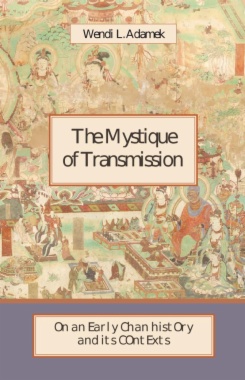The Mystique of Transmission is a close reading of a late-eighth-century Chan/Zen Buddhist hagiographical work, the Lidai fabao ji (Record of the Dharma-Jewel Through the Generations), and is its first English translation. The text is the only remaining relic of the little-known Bao Tang Chan school of Sichuan, and combines a sectarian history of Buddhism and Chan in China with an account of the eighth-century Chan master Wuzhu in Sichuan.
Chinese religions scholar Wendi Adamek compares the Lidai fabao ji with other sources from the fourth through eighth centuries, chronicling changes in the doctrines and practices involved in transmitting medieval Chinese Buddhist teachings. While Adamek is concerned with familiar Chan themes like patriarchal genealogies and the ideology of sudden enlightenment, she also highlights topics that make Lidai fabao ji distinctive: formless practice, the inclusion of female practitioners, the influence of Daoist metaphysics, and connections with early Tibetan Buddhism.
The Lidai fabao ji was unearthed in the early twentieth century in the Mogao caves at the Silk Road oasis of Dunhuang in northwestern China. Discovery of the Dunhuang manuscripts has been compared with the discovery of the Dead Sea Scrolls, as these documents have radically changed our understanding of medieval China and Buddhism. A crucial volume for students and scholars, The Mystique of Transmission offers a rare glimpse of a lost world and fills an important gap in the timeline of Chinese and Buddhist history.
- CONTENTS
- Acknowledgments
- PART 1: The Mystique of Transmission
- Chapter 1: Authority and Authenticity
- Fabrications
- On the Background of the Lidai Fabao Ji
- An Overview
- Chapter 2: Transmission and Translation
- The Challenge of Continuity
- Summary of the Contents of the Lidai Fabao Ji
- Emperor Ming of the Han
- Daoan and Transmission of Forms
- Buddhabhadra and Transmission of Lineage
- Huiyuan’s Transmission of Space and Place
- The Mystique of Legitimacy
- Conclusion
- Chapter 3: Transmission and Lay Practice
- The Interdependence of Lay and Ordained Practice
- Criteria of Authenticity of the Dharmaand the Authority of the Ordained
- The Role of the Bodhisattva Precepts in Lay Devotional Practice
- Conclusion
- Chapter 4: Material Buddhism and the Dharma Kings
- The Dangers of Empire
- The Northern Wei and Spiritual Materialism
- Empires of Signs
- The Legacy of Tiantai Zhiyi
- The Renwang Jing
- The Sanjie (three levels) Movement
- Imaginary Cultic Robes
- Conclusion
- Chapter 5: Robes and Patriarchs
- The “Chan” Question
- Tales of the Chan Patriarchs
- A Genealogy of Patriarchal Lineages
- Shenhui’s Rhetoric
- Inconceivable Robes in the Vajrasamādhi-sūtra
- Robes Purple and Gold
- The Reforms of Emperor Xuanzong
- Chapter 6: Wuzhu and His Others
- The Second Part of the Lidai Fabao Ji
- A Note about Style
- Mass Precepts Ceremonies and Formless Precepts
- Transmission from Wuxiang to Wuzhu
- Locating Wuzhu
- Antinomianism in the Monastery
- Women in the Lidai Fabao Ji
- Daoists in the Dharma Hall
- Chapter 7: The Legacy of the Lidai Fabao Ji
- The Portrait-Eulogy for Wuzhu
- Developments After the Lidai Fabao Ji
- Conclusion
- PART 2: Annotated Translation of the Lidai fabao ji
- Section 1: Sources and the Legend of Emperor Ming of the Han
- Section 2: Buddhism in China
- Section 3: Transmission from India to China
- Section 4: The First Patriarch, Bodhidharmatrāta
- Section 5: The Second Patriarch, Huike
- Section 6: The Third Patriarch, Sengcan
- Section 7: The Fourth Patriarch, Daoxin
- Section 8: The Fifth Patriarch, Hongren
- Section 9: The Sixth Patriarch, Huineng, Part 1
- Section 10: Dharma Master Daoan and Scripture Quotations
- Section 11: Huineng, Part 2
- Section 12: Zhishen and Empress Wu
- Section 13: Chan Master Zhishen
- Section 14: Chan Master Chuji
- Section 15: Chan Master Wuxiang
- Section 16: The Venerable Shenhui
- Section 17: Discourses of the Venerable Wuzhu
- Section 18: Wuzhu and Wuxiang
- Section 19: Du Hongjian’s Arrival in Shu
- Section 20: Du Hongjian and Wuzhu Meet
- Section 21: Cui Gan Visits Wuzhu
- Section 22: Dialogue with Chan Master Tiwu
- Section 23: Dialogue with Chan Master Huiyi
- Section 24: Dialogue with Masters Yijing, Zhumo, and Tangwen
- Section 25: Dialogue with Master Jingzang
- Section 26: Dialogue with Master Zhiyi
- Section 27: Dialogue with Master Zhongxin
- Section 28: Dialogue with Dharma Master Falun
- Section 29: Dialogue with the Brothers Yixing and Huiming
- Section 30: Dialogue with Changjingjin and Liaojianxing(Female Disciples)
- Section 31: Excerpts and Quotations, Part 1
- Section 32: Excerpts and Quotations, Part 2
- Section 33: Tea Gāthā
- Section 34: Dialogue with Daoists
- Section 35: Dialogue with Dharma Masters
- Section 36: Dialogue with Vinaya Masters
- Section 37: Dialogue with Treatise Masters
- Section 38: Trading Quotations with Masters Daoyou, Mingfa, and Guanlu
- Section 39: Taking on Chan Disciples While Drinking Tea
- Section 40: Dialogue with Master Xiongjun
- Section 41: Dialogue with Master Fayuan, Accompanied by His Mother
- Section 42: Discourse to Lay Donors
- Section 43: Portrait-Eulogy and Final Scene
- NOTES
- Appendix
- Abbreviations
- Bibliography
- INDEX

